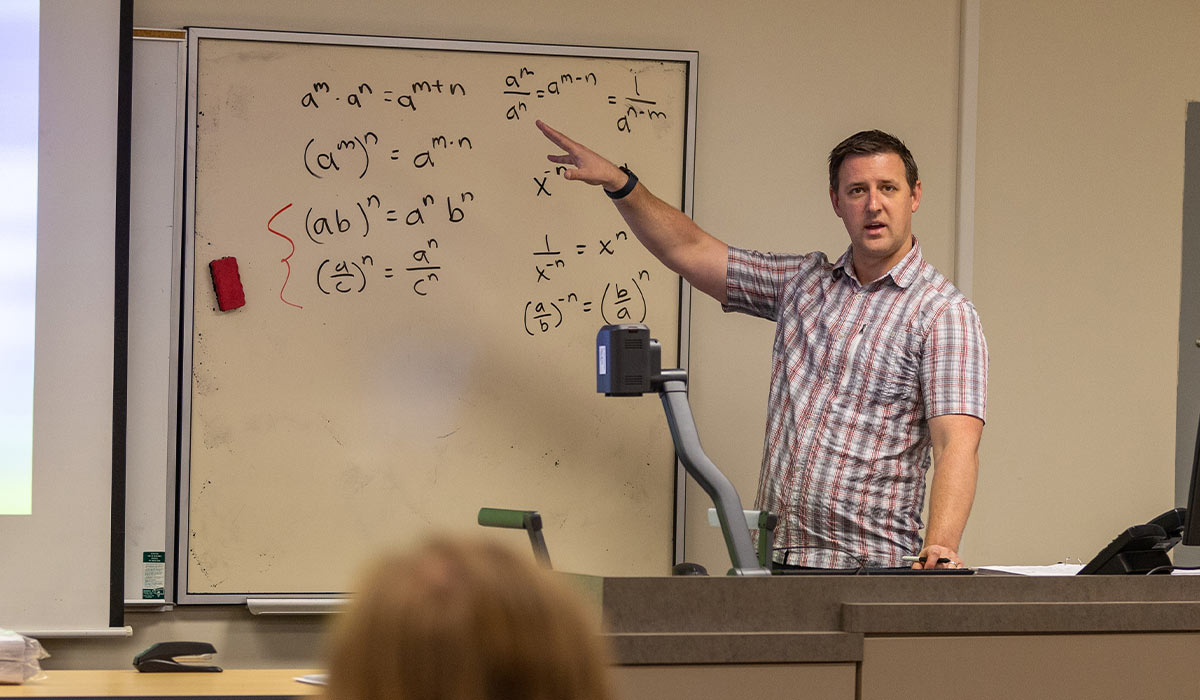The subject that spawns the most anxiety for students of any age is math.
For many potential or current college students, worries about their mathematical abilities can impact their plans about what to study. Meanwhile, the prospect of needing to take remedial math courses that lengthen the time to earn their degree — and increase its cost — puts up a barrier to their ultimate success.
Over the past few years, however, Yakima Valley College’s faculty have been reimagining how students do math. Their efforts to-date are already making a big impact, with more students, especially historically underserved students of color, achieving success in math.
Solving for student success
At many community colleges around the country, a large percentage of students have historically been placed in developmental math courses in order to prove they’ll be able to succeed in college-level courses. At YVC, until recently, more than 60% of students were placed in those courses.
In 2020, however, YVC Math Instructor Matt Lewis attended a workshop that opened his eyes to the possibility of rethinking the college’s sequence of math courses, which could require a student to pass up to five quarters of math in order to complete their college-level math requirement. For students who placed into the first course in that sequence, only 10.7% of all students and 8.2% of students of color met their quantitative requirement for graduation within two years.
“The success rates for students were just not acceptable,” said Lewis. “With such a low percentage earning their math requirement, it wasn’t a big leap of logic to say that’s got to be one of the main stumbling blocks to students ultimately graduating.”
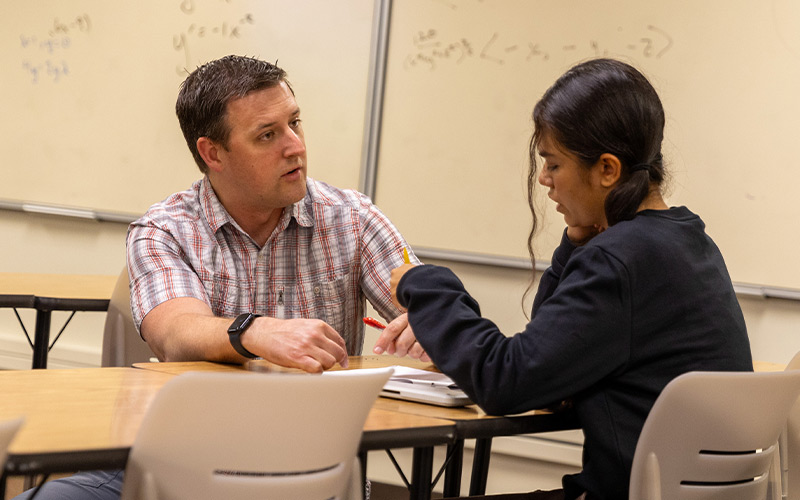
YVC Math Instructor Matt Lewis talks with a student during a Fall 2024 math class.
To remove that barrier, Lewis and other math faculty took a hard look at YVC’s math pathways and how to get all students into their college-level math course within a maximum of three quarters and, for as many students as possible, within one or two quarters.
“The idea was, for as many students as you can, get them into the college-level math,” said Lewis. “But if you realize they have some holes in their knowledge, then have them add on a two- or three-credit [co-requisite support] class while they’re in their college-level math class and give them the information they need to be successful that way, rather than making them wait another quarter or more.”
To accomplish that, a sequence of up to four developmental math courses spanning arithmetic to intermediate algebra were scrapped. Now, a student on a STEM or Business pathway will need to take a maximum of two developmental courses before starting college-level math, while students in other pathways will only need a single developmental course.
Lewis notes that most of the content in the discontinued courses still exists in the revamped math courses.
“The difference is before, we had students basically do remediation on all the math that we think they may need to review and that they might need at the college-level,” Lewis said. “The [new] co-requisite model allows us to be more targeted.”
For example, a student taking statistics as their college-level course will need specific prior knowledge to be successful in that course. Therefore, the co-requisite course that accompanies the college-level statistics focuses on boosting their proficiency with that content.
“We took the content that was in those old, discontinued courses and we said ‘Let’s grab the stuff we need from those and be more targeted with what we’re having students review’,” Lewis said.
The placement problem
The recent overhaul of the college’s math courses wasn’t the only reform effort. The department also adopted a new process for placing students into math courses.
Math Instructor Mike Jenck has been working on placement since he first joined YVC’s faculty in 2003. At the onset of the pandemic, with students unable to do their math placement on campus, the department shifted to having students complete a self-guided assessment.
That assessment presents students with 14 questions and asks them to give their confidence level in solving it. It takes an average of 15-20 minutes to complete and, while there was some trepidation that students would overrate their math abilities, Jenck said that success rates in most classes have held fairly steady since the new placement was adopted.
“We realize people can underestimate their skills as well as overestimate them,” he said. “I think that’s kind of a natural fear, especially when it’s a subject a lot of people ‘hate’ or believe ‘I’m not good at’ because that’s what they’ve always been told, whether it’s true or not.”
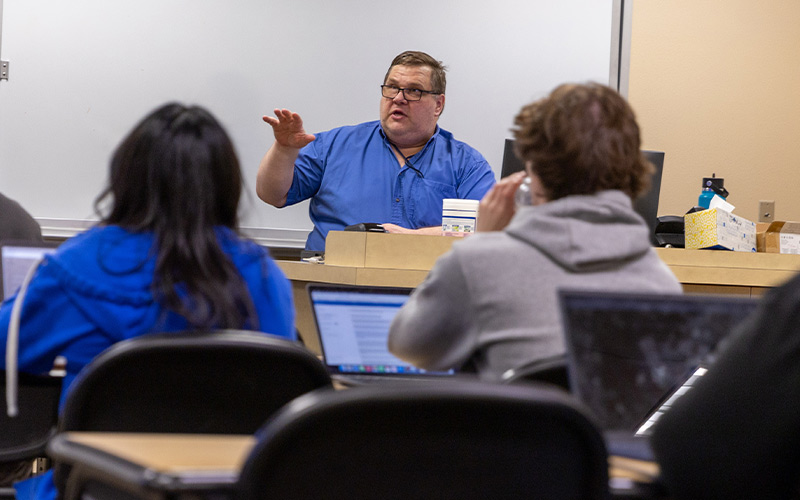
Math Instructor Mike Jenck in class during Fall 2024.
Since the changes to YVC’s placement process, Jenck said he’s seen more students make it to college-level courses that, in the past, would have stopped their education while still working their way through the developmental math sequence.
“Given the opportunity and the support, they can pass their college-level class now,” Jenck said. “They’re going to get that 100-level math and then their dreams now can become a reality. And that’s the big thing. When you squash those dreams, it’s not just that one student, it’s that family as well.
“Every person has got to be able to get ahead for themselves, to better themselves, because that's what drives our economy forward — the idea that I can do better than what I did yesterday.”
Showing results
During the 2022-23 academic year, when YVC’s new math sequence was implemented, the percentage of students enrolled in college-level courses more than doubled compared to the previous four academic years, from 35.5% to 72.5%. Moreover, the college-level math enrollment gap between historically underrepresented students of color and other students has shrunk significantly, from 10.9 percentage points to 3.8 points.
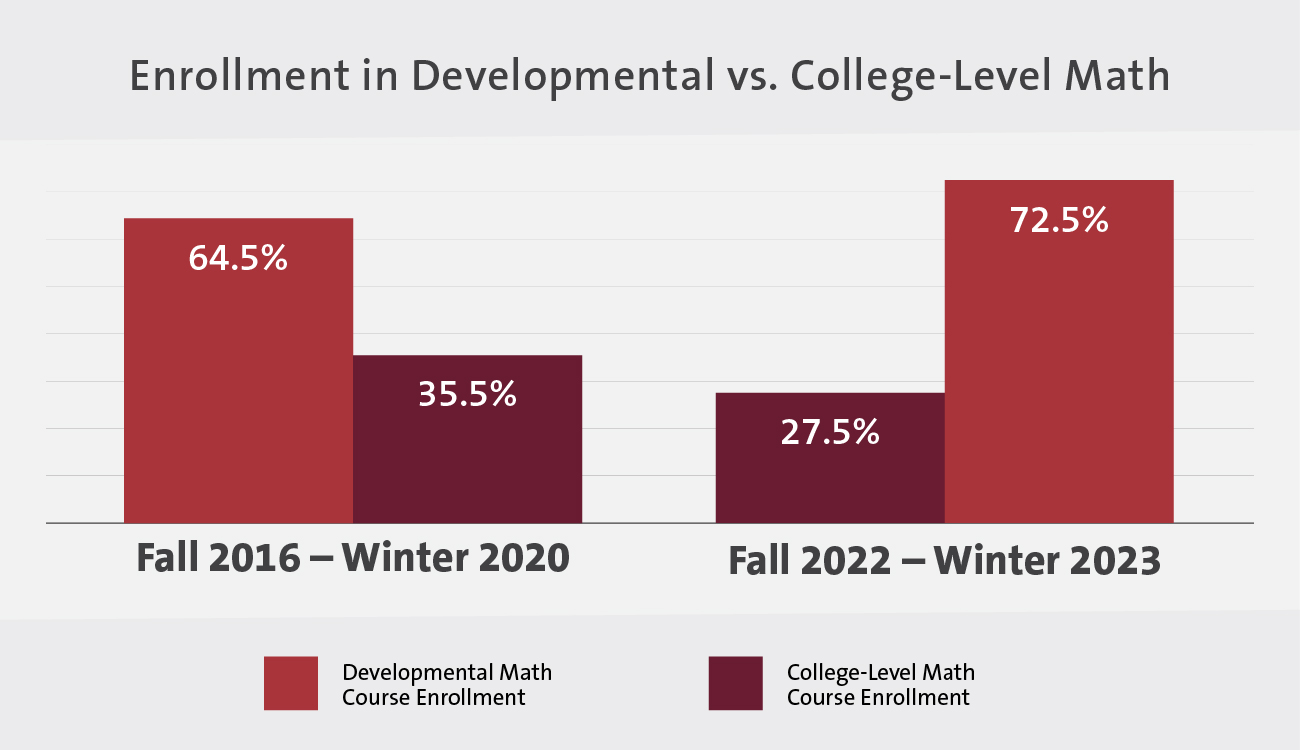
Even as many more students are taking college-level math courses sooner than in the past, overall success rates have only dropped slightly, from 77.4% successfully completing their course to 73.9% post-reform.
As for the key objective of more students completing their college-level math within one year of enrollment, the overall percentage of YVC students achieving that benchmark increased by 12 percentage points to 39.1% following the reforms, led by an 82.7% increase in the percentage of historically underrepresented students of color. Shrinking the equity gap between those underrepresented students and other students from 7.4 points to 3.1 points is a notable achievement, Lewis said, even as math faculty explore opportunities to continue the department’s progress.
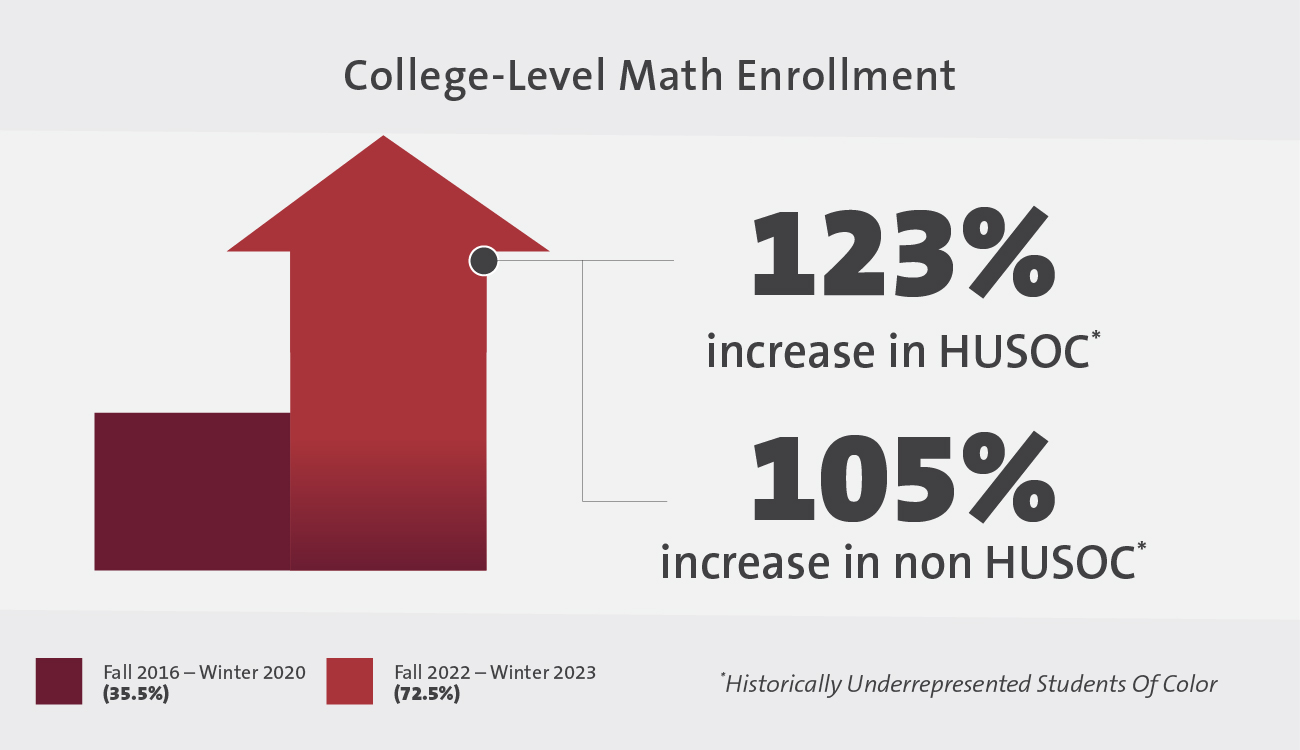
“It's really gratifying and, like any large-scale reform, there's some things that we look at and we say, ‘OK, we still need to make improvements here.’ But we know we did the right thing,” Lewis said.
He and other faculty members also see the reforms sparking greater confidence among students about the ability to successfully complete their degree, which can play a critical role in encouraging students to persist in their education.
“Especially when [these reforms] first started where you have students that had seen the old pathway and then the new pathway, they were pretty excited. Like ‘OK, I can do that. I can do a quarter or two quarters versus the four quarters that I thought I had to do before’,” Lewis said.
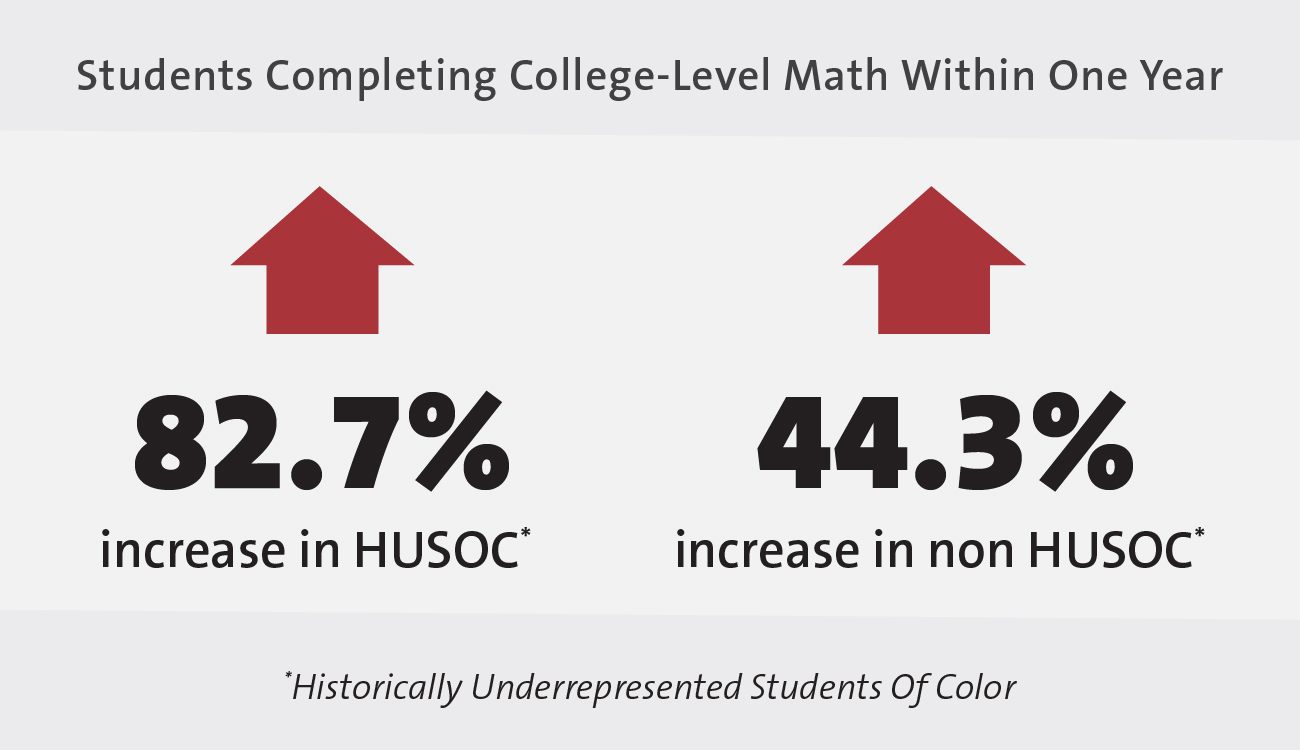
YVC is among the first institutions in Washington’s community and technical college system to implement streamlined math pathways to help students complete their college-level math requirement more quickly. After implementing its reforms, for the Fall 2022 and Winter 2023 quarters, YVC rose to rank third among the state’s community and technical colleges in the percentage of students completing college-level math within one year, 7.3 percentage points above the average for other colleges in the system.
“The way everyone [in the math department] just pulled together and said ‘Let's do this,’ it was taking on a huge task,” said Lewis, “but it was something that we came together and contributed to. I think it says a lot about our faculty that they're committed to making data-driven decisions and then, when the data tells us hard things, are willing to do hard work to address it.”
Story and photos by Dustin Wunderlich, director of community relations.
